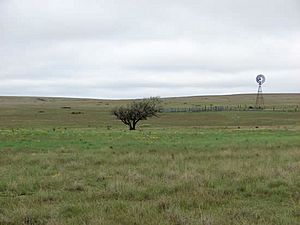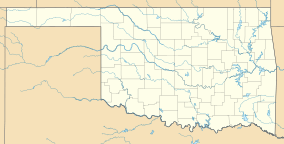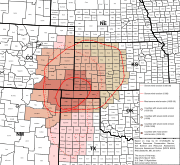Rita Blanca National Grassland facts for kids
Quick facts for kids Rita Blanca National Grassland |
|
|---|---|
 |
|
| Location | Dallam County, Texas and Cimarron County, Oklahoma, United States |
| Nearest city | Dalhart, Texas |
| Area | 92,989 acres (376.31 km2) |
| Governing body | U.S. Forest Service |
| Website | Kiowa and Rita Blanca National Grasslands |
The Rita Blanca National Grassland is a special protected area of land. It's located on the Great Plains in both Texas and Oklahoma. You can find it near the town of Texline in northwest Dallam County, Texas. It also stretches into southern Cimarron County, Oklahoma. The closest big town is Dalhart, Texas.
The name Rita Blanca means "Little White River" in Spanish. Spanish sheep herders gave this name to a stream long ago in the 1800s. Later, a large ranch called the XIT Ranch used the name. Now, many places in the area share the name Rita Blanca.
Contents
Why Was Rita Blanca National Grassland Created?
The Dust Bowl: A Big Problem in the 1930s
The Rita Blanca National Grassland, along with the Kiowa National Grassland in New Mexico, exists because of a tough time in history called the Dust Bowl. This happened in the 1930s. During the Dust Bowl, severe droughts and strong winds caused huge dust storms across the Great Plains. Farmers had plowed up too much of the natural grassland. This left the soil loose and unprotected.
The Dust Bowl showed the U.S. Government that farming everywhere on the Great Plains was not a good idea. The weather there made it very difficult.
How the Government Helped Restore the Land
To fix the problem, the government passed new laws. The National Industrial Act (1933) and the Emergency Relief Appropriations Act (1935) allowed the government to buy back farmland that had failed. Then, the Bankhead-Jones Farm Tenant Act of 1937 helped transfer about 3.85 million acres (15,600 square kilometers) of this land. The goal was to restore the soil and protect the grasslands.
Finally, in 1960, the U.S. Congress officially created the Kiowa and Rita Blanca National Grasslands. This helped protect these important natural areas.
What Is Rita Blanca National Grassland Like?
Size and Location of the Grassland
The Rita Blanca National Grassland is not one big, solid piece of land. Instead, it's made up of several smaller sections of land owned by the U.S. Forest Service. These sections are mixed in with private land.
The elevation of the grassland changes quite a bit. It's highest at about 4,700 feet (1,433 meters) in Oklahoma. It drops to about 3,700 feet (1,128 meters) in Texas. The total area of the grassland is about 92,989 acres (376 square kilometers). Most of it, about 77,463 acres (313 square kilometers), is in Texas. The rest, about 15,860 acres (64 square kilometers), is in Oklahoma.
Plants and Animals Living Here
The climate in this area is semi-arid, meaning it's quite dry. The main type of plant life you'll see is shortgrass. This grassland is home to many different animals. You might spot pronghorn (a type of antelope), rabbits, prairie dogs, and coyotes. Many birds that hunt, like hawks and eagles, also live here.
Who Manages the Grassland?
The Rita Blanca National Grassland is managed by the Cibola National Forest. This forest also oversees other grasslands in the Great Plains, like the Black Kettle, Kiowa, and McClellan Creek National Grasslands. The main office for the Cibola National Forest is in Albuquerque, New Mexico. There are also local offices, like one in Clayton, New Mexico.
Ecology: The Living Systems of the Grassland
Studying the Plants and Animals
In 2009, a group of scientists led by Donald L. Hazlett studied the Kiowa and Rita Blanca National Grasslands. They looked at the history of the land and all the living things there. They shared their findings with the U.S. Department of Agriculture, Forest Service.
They discovered that the Rita Blanca National Grassland has a very complex natural system. It's full of many different kinds of plants and animals. For example, they found 826 different types of vascular plants. These plants belonged to 81 different plant families! This shows how rich and diverse the grassland's ecosystem is.
Images for kids
-
This map shows the states and counties that were affected by the Dust Bowl between 1935 and 1938. The areas hit hardest are shown in dark red.





